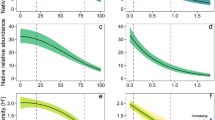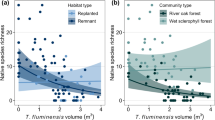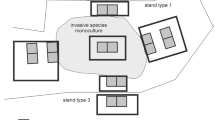Abstract
Quantifying per capita impacts of invasive species on resident communities requires integrating regression analyses with experiments under natural conditions. Using multivariate and univariate approaches, I regressed the abundance of 105 resident species of groundcover plants and tree seedlings against the abundance and height of an invasive grass, Microstegium vimineum, within 117 plots in four mesic floodplain forests in Mississippi (USA). Microstegium vimineum was most productive (i.e., tallest and most abundant) in canopy gaps in floodplains, and a significant amount of variation in resident species composition was directly explained by canopy gaps and stand age. The relatively small (but statistically significant) percentage of variation in resident species composition (1.8%) explained by M. vimineum in the multivariate analysis was attributable to significant relationships with a few common species. Most of these were negative relationships with shady mesic forest indicators. Most positive relationships were with infrequent disturbance indicators and with species with growth phenologies that differed from that of M. vimineum. Results of field competition experiments with the three most common species to show significant relationships with M. vimineum revealed asymmetric competitive effects of M. vimineum on Chasmanthium laxum and positive responses of Quercus alba seedlings and Leersia virginica adults to the removal of M. vimineum in one growing season. Results of this study suggest that negative per capita community-level effects of M. vimineum are likely to be greater in shady forests than in open floodplain forests due to the relative paucity of vulnerable species in the latter.







Similar content being viewed by others
References
Adams SN, Engelhardt KAM (2009) Diversity declines in Microstegium vimineum (Japanese stiltgrass) patches. Biol Conserv 142:1003–1010
Alvarez ME, Cushman JH (2002) Community-level consequences of a plant invasion: effects on three habitats in coastal California. Ecol Monogr 12:1434–1444
Barden LS (1987) Invasion of Microstegium vimineum (Poaceae), an exotic, annual shade-tolerant, C-4 grass, into a North Carolina floodplain. Am Midl Nat 118:40–45
Belote R, Weltzin J (2006) Interactions between two co-dominant, invasive plants in the understory of a temperate deciduous forest. Biol Invasions 8:1629–1641
Brewer JS (2008) Declines in plant species richness and endemic plant species in longleaf pine savannas invaded by Imperata cylindrica. Biol Invasions 10:1257–1264
Brewer JS (2010) A potential conflict between preserving regional plant diversity and biotic resistance to an invasive grass, Microstegium vimineum. Nat Areas J 30:279–293
Brewer JS, Menzel T (2009) A method for evaluating the outcome of restoration when no reference sites exist. Restor Ecol 17:4–11
Bruno JF, Fridley JD, Bromberg KD, Bertness MD (2005) Insights into biotic interactions from studies of species invasions. In: Sax DF, Stachowicz JJ, Gaines SD (eds) Species invasions: insights into ecology, evolution, and biogeography. Sinauer Associates, Inc., Sunderland, pp 13–40
Cheplick GP (2008) Growth trajectories and size-dependent reproduction in the highly invasive grass Microstegium vimineum. Biol Invasions 10:761–770
Cole PG, Weltzin JF (2004) Environmental correlates of the distribution and abundance of Microstegium vimineum, in east Tennessee. Southeastern Naturalist 545–562
Cole PG, Weltzin JF (2005) Light limitation creates patchy distribution of an invasive grass in eastern deciduous forests. Biol Invasions 7:477–488
Collier MH, Vankat JL, Hughes MR (2002) Diminished plant richness and abundance below Lonicera maackii, an invasive shrub. Am Midl Nat 147:60–71
Davis MA, Grime JP, Thompson K (2000) Fluctuating resources in plant communities: a general theory of invasibility. J Ecol 88:528–534
Ehrenfeld JG, Kourtev P, Huang W (2001) Changes in soil functions following invasions of exotic understory plants in deciduous forests. Ecol Appl 11:1287–1300
Fairbrothers DE, Gray JR (1972) Microstegium vimineum (Trin.) A. Camus (Gramineae) in the United States. Bull Torrey Bot Club 99:97–100
Flory SL, Clay K (2010) Non-native grass invasion alters native plant composition in experimental communities. Biol Inv 12:1285–1294
Gibson DJ, Spyreas G, Benedict J (2002) Life history of Microstegium vimineum (Poaceae), an invasive grass in southern Illinois. J Torrey Bot Soc 129:207–219
Glasgow LS, Matlack GR (2007) The effects of prescribed burning and canopy openness on establishment of two non-native plant species in a deciduous forest, southeast Ohio, USA. For Ecol Manag 238:319–329
Gurevitch J, Padilla DK (2004) Are invasive species a major cause of extinctions? Trends Ecol Evol 19:470–474
Hager HA, McCoy KD (1998) The implications of accepting untested hypotheses: a review of the effects of purple loosestrife (Lythrum salicaria) in North America. Biodivers and Conserv 7:1069–1079
Horton JL, Neufeld HS (1998) Photosynthetic responses of Microstegium vimineum (Trin.) A. Camus, a shade-tolerant, C4 grass, to variable light environments. Oecologia 114:11–19
Huebner CD (2010) Establishment of an invasive grass in closed-canopy deciduous forests across local and regional environmental gradients. Biol Invasions 12:2069–2080
Hunt DM, Zaremba RE (1992) The northeastward spread of Microstegium vimineum (Poaceae) into New York and adjacent states. Rhodora 94(878):167–170
Huston MA (2004) Management strategies for plant invasions: manipulating productivity, disturbance, and competition. Diversity Distrib 10:167–178
Jones RL (2005) Plant life of Kentucky: an illustrated guide to the vascular flora. University Press of Kentucky, Lexington
Legendre P, Anderson MJ (1999) Distance-based redundancy analysis: testing multispecies responses in multifactorial ecological experiments. Ecol Monogr 69:1–24
Leicht SA, Silander JA Jr, Greenwood K (2005) Assessing the competitive ability of Japanese stiltgrass, Microstegium vimineum (Trin) A. Camus. J Torrey Bot Soc 132:573–580
Levine JM (2000) Species diversity and biological invasions: relating local process to community pattern. Science 288:852–854
Levine JM, D’Antonio CM (1999) Elton revisited: a review of evidence linking diversity and invasibility. Oikos 87:15–26
MacDougall AS, Turkington R (2005) Are invasive species the drivers or passengers of change in degraded ecosystems? Ecol 86:42–55
Marshall JM, Buckley DS (2008) Influence of litter removal and mineral soil disturbance on the spread of an invasive grass in a Central Hardwood forest. Biol Invasions 10:531–538
Marshall JM, Buckley DS, Franklin JA (2009) Competitive interaction between Microstegium vimineum and first-year seedlings of three central hardwoods. J Torrey Bot Soc 136:342–349
McArdle BH, Anderson MJ (2001) Fitting multivariate models to community data: a comment on distance-based redundancy analysis. Ecol 82:290–297
McCarthy BC (1997) Response of a forest understory community to experimental removal of an invasive nonindigenous plant (Alliaria petiolata, Brassicaceae). In: Luken J, Thieret J (eds) Assessment and management of plant invasions. Springer, New York, pp 117–130
Meiners SJ, Pickett STA, Cadenasso ML (2001) Effects of plant invasions on the species richness of abandoned agricultural land. Ecography 24:633–644
Morrison JA, McMahon H, Mauck K, McCartney KM, Dunn B (2007) Ecological comparison of two co-invasive species in eastern deciduous forests: Alliaria petiolata and Microstegium vimineum. J Torrey Bot Soc 134:1–17
Oswalt CM, Oswalt SN, Clatterbuck WK (2007) Effects of Microstegium vimineum (Trin.) A. Camus on native woody species density and diversity in a productive mixed-hardwood forest in Tennessee. For Ecol Manag 242:727–732
Parker IM, Simberloff D, Lonsdale WM, Goodell K, Wonham M, Kareiva PM, Williamson MH, Von Holle B, Moyle PB, Byers JE, Goldwasser L (1999) Impact: toward a framework for understanding the ecological effects of invaders. Biol Invasions 5:45–51
Redman DE (1995) Distribution and habitat types for Nepal Microstegium [Microstegium vimineum (Trin.) Camus] in Maryland and the District of Columbia. Castanea 60:270–275
Schooler SS, McEvoy PB, Coombs EM (2006) Negative per capita effects of purple loosestrife and reed canary grass on plant diversity of wetland communities. Diversity Distrib 12:351–363
Simao MCM, Flory SL, Rudgers JA (2010) Experimental plant invasion reduces arthropod abundance and richness across multiple trophic levels. Oikos Online Publication, doi: 10.1111/j.1600-0706.2010.18382.x. Accessed July 21, 2010
Stachowicz JJ, Tilman D (2005) Species invasions and the relationships between species diversity, community saturation, and ecosystem functioning. In: Sax DF, Stachowicz JJ, Gaines SD (eds) Species invasions: insights into ecology, evolution, and biogeography. Sinauer Associates, Inc, Sunderland, pp 41–64
Surrette SB, Brewer JS (2008) Inferring relationships between native plant diversity and Lonicera japonica in upland forests in north Mississippi, USA. Appl Veg Sci 11:205–214
Von Holle B, Motzkin G (2007) Historical land use and environmental determinants of nonnative plant distribution in coastal southern New England. Biol Conserv 136:33–43
Winter K, Schmidt MR, Edwards GE (1992) Microstegium vimineum, a shade adapted C-4 (carbon pathway) grass (comparison of growth with Digitaria sanguinalis and Sporobolus airoides). Plant Sci Lett 24:311–318
Woods KD (1993) Effects of invasion by Lonicera tatarica L. on herbs and tree seedlings in four New England forests. Am Midl Nat 130:62–74
Zavaleta ES, Hulvey KB (2004) Realistic species losses disproportionately reduce grassland resistance to biological invaders. Science 306:1175–1177
Acknowledgments
I thank C.A. Bertz, K. Griffin, T. Moore, E. Maynard, J. Chesser, and C. Pope for help in the field. The comments of three anonymous reviewers and Travis Belote improved the manuscript. The research was funded by the National Audubon Society and a cooperative agreement (USDA 07-CA-11330127-128) between the University of Mississippi and the USDA Forest Service, Southern Research Station, Center for Bottomland Hardwoods Research, Stoneville, Mississippi, USA.
Author information
Authors and Affiliations
Corresponding author
Appendix
Appendix
See Table 2.
Rights and permissions
About this article
Cite this article
Brewer, J.S. Per capita community-level effects of an invasive grass, Microstegium vimineum, on vegetation in mesic forests in northern Mississippi (USA). Biol Invasions 13, 701–715 (2011). https://doi.org/10.1007/s10530-010-9861-1
Received:
Accepted:
Published:
Issue Date:
DOI: https://doi.org/10.1007/s10530-010-9861-1




